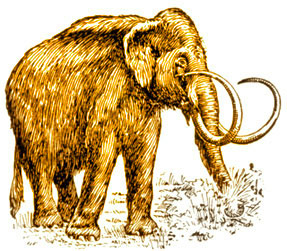Humans and global warming responsible for extinction of mammoths
Humans and global warming responsible for extinction of mammoths
mongabay.com
March 31, 2008
Study confirms that habitat fragmentation, caused by climate change, split species into small populations, making them more vulnerable to extinction.
The combination of human hunting pressure and climate change was responsible for the extinction in woolly mammoths, claims new research published in the open-access journal PLoS Biology.
Scientists have long debated whether climate change or human hunting were the more important driver in the demise of North America’s megafauna towards the end of the last Ice Age. Now new modeling by David Nogues-Bravo, a biologist at the National Museum of Natural Sciences in Madrid, Spain, and colleagues supports the theory that synergistic effects of warming climate and new human predators drove mammoths to extinction.

Woolly mammoth. Image courtesy of the Lawrence Berkeley National Laboratory |
Comparing historic temperature and rainfall with the age and locations of fossils, the researchers modeled climate and species distribution at different times in mammoth history — 126,000, 42,000, 30,000, 21,000, and 6,000 years ago. The results show that the mammoth (Mammuthus primigenius) suffered a 90 percent loss of its geographic range between 42,000 and 6,000 years ago due to climate change, triggering a sharp decline in population. While mammoths had previously recovered from a worse loss of habitat some 126,000 years ago, the addition of human hunters 6,000 years ago sealed their fate. Nogues-Bravo and colleagues estimate that under the most optimistic scenario for mammoth populations, the killing of a single mammoth every three years would have been enough to drive the species to extinction. In a pessimistic scenario, extinction would require the killing of only a single mammoth every two hundred years.
“These results support the view that the synergy between the collapse of suitable climatic conditions for the woolly mammoths and northward increase in human population densities during the Holocene set the place and time of the woolly mammoth’s extinction,” write the authors. “Our results suggest that climate change and human impacts progressively cornered the mammoth in the northernmost land masses of Arctic Siberia and some arctic islands, leaving them with nowhere to run away from extinction.”
Citation: Nogués-Bravo D, Rodríguez J, Hortal J, Batra P, Araújo MB (2008) Climate change, humans, and the extinction of the woolly mammoth. PLoS Biol 6(4): e79. doi:10. 1371/journal.pbio.0060079
Related
Man may be responsible for prehistoric extinctions
May 5, 2006 New research suggests that prehistoric horses in Alaska may have been hunted into extinction by man, rather than doomed by climate change as previously thought. The study is published this week in Proceedings of the National Academy of Sciences (PNAS).
Supernova could be responsible for extinction of the mammoth
September 24, 2005 A distant supernova that exploded 41,000 years ago may have led to the extinction of the mammoth, according to research that will be presented tomorrow (Sept. 24) by nuclear scientist Richard Firestone of the U.S. Department of Energy’s Lawrence Berkeley National Laboratory (Berkeley Lab).














